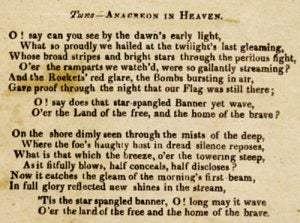 MYTH #3: Francis Scott Key wrote a “poem” later set to music by someone else
MYTH #3: Francis Scott Key wrote a “poem” later set to music by someone else
CORRECTION: “The Star-Spangled Banner” was always conceived of by Key as a song and he wrote his “lyric” to fit a specific melody of his own choosing
Usually referred to as a poet, Francis Scott Key is more accurately remembered—at least in connection with “The Star-Spangled Banner”—as a lyricist. In fact, he wrote lyrics for a total of three songs and ten hymns. In all cases, he invented words to fit previously existing musical models. This was typical in Key’s era when hand-engraved music notation was expensive, but printing words was common, fast, and pretty cheap. In one strategy known as the broadside ballad tradition, lyrics would be written to match the rhythm and contour of familiar tunes and published as text only in newspapers and books. The melodies for these “broadside ballads” were usually identified by a note just below their title. The most successful of these lyrics went “viral” and were reprinted by local newspapers (all newspapers were local at this time, of course).

The very first printing of Key’s now famous lyric, for example, indicated that the words were to be sung to the “Tune—Anacreon in Heaven.” Known also as “To Anacreon in Heaven” or “The Anacreontic Song,” this composition was the anthem of a late-eighteenth-century amateur musician’s club in London, England called The Anacreontic Society. Although a bit different in details of rhythm and melodic contour, its melody is easily recognizable as the tune sung today in performances of “The Star-Spangled Banner.”
We are also certain that Key knew the Anacreontic melody before he wrote “The Star-Spangled Banner,” because he had used the melody before. Nine years before the attack on Baltimore, Key wrote his first patriotic song—”When the Warrior Returns”—to honor Lieutenant Stephen Decatur, Jr. and Charles Stewart, two heroes of the Tripolitan War. Following broadside practice, Key wrote the words to fit the melody of “The Anacreontic Song” and reportedly sang the song himself at a dinner in the heroes’ honor. Key would even reuse several poetic devices from this 1805 song in “The Star-Spangled Banner.” These include rhymes such as “wave” and “brave,” the “war’s desolation,” and most importantly the phrase “star-spangled” to describe the “flag of our nation.”
Skip to 2:45 to hear Jean Bernard Cerin sing “When the Warrior Returns” (FS Key)
To download our edition of the sheet music, click here.
The melody of “The Anacreontic Song” was used frequently for broadside ballads in Key’s era. More than 80 Anacreontic lyrics appeared in print before 1820. As a poetic form, it was unique. It features eight-line stanzas—four is typical—and these eight lines contain nine rhymes. Each line has an end rhyme plus there is an extra internal rhyme in line five. Key’s 1814 lyric has this extra rhyme in the phrase “And the rockets red glare, the bombs busting in air, gave proof through the night that our flag was still there.” It therefore fits precisely the structural model unique to parodies of “The Anacreontic Song.” It is simply implausible that Key could write an eight-line lyric with nine rhymes by chance.
Nevertheless, because Key did not preserve for history a first-hand account of his writing of the Banner, others including the musician Ferdinand Durang and Key’s own brother-in-law, the Supreme Court Chief Justice Roger B. Taney, claimed to have been the one to have brought text and tune together. Maybe they noticed what Key had done, but in its day, any and all readers would have understood it to be a broadside ballad and its distinctive line and rhyme scheme fit one and only tune, a popular melody that Key had used before—”The Anacreontic Song” (Click here for video; here for sheet music).
Was “The Anacreontic Song” really a drinking song? Check out Spangled Mythconception #4 tomorrow…
SPANGLED MYTHCONCEPTIONS SERIES, by Mark Clague, Ph.D.
#2 Key Wrote Anthem on an Envelope | Intro | #4 Banner Is Based on a Drinking Song

